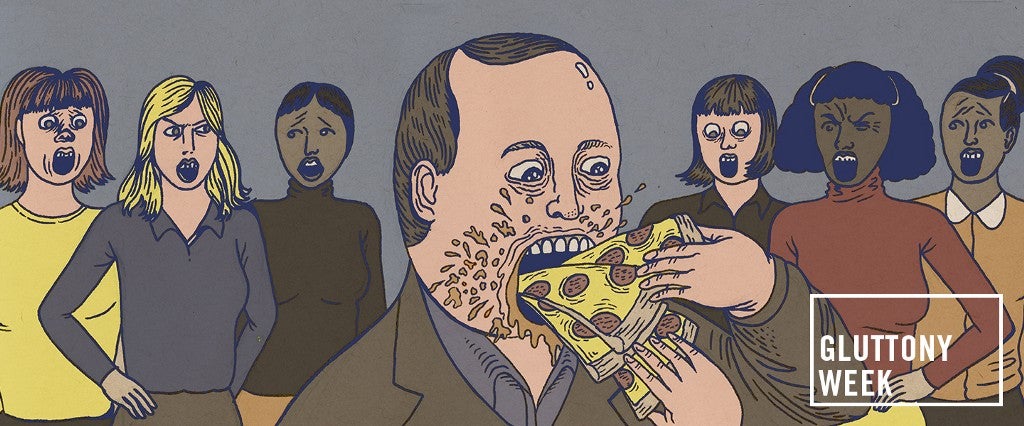Since pretty much forever, men have attempted to impress women in any number of ways, from watches to cufflinks to eyeliner to fast cars to flashy clothes to good deeds.
None of this, of course, is surprising. Attempting to attract women with glimpses of luxury and acts of kindness makes a certain amount of sense. But what about devouring a ton of pizza in front of them?
Trying to impress a woman by inhaling a bunch of fat and carbs may sound absurd, but it turns out men do overeat to show off. “Instead of a feat of strength, it’s a feat of eating,” says Kevin Kniffin, a visiting assistant professor at Cornell University, who conducted a study last year observing the eating habits of 133 adults at an all-you-can-eat Italian buffet over a two-week period. In a woman’s presence, men ate 93 percent more pizza and 86 percent more salad.
It’s a form of “self-handicapping,” Kniffin says. That is to say, it’s a way of flaunting one’s Darwinian fitness by engaging in things that may appear harmful — like repeatedly wiping out on a BMX bike, attempting to smoke 154 cigarettes at once or hoovering up slices of Papa John’s — to demonstrate, consciously or unconsciously, that you have so much surplus health and energy that you can afford to engage in such risky behavior.
A separate but related type of gastronomical peacocking involves spicy food, long considered a litmus test of the masculine palate. Two years ago, researchers from Pennsylvania State University polled 246 test subjects about their favorite foods, gave them a personality survey and had them sample a flight of intense flavors including capsaicin, the chemical that gives peppers their heat. When asked, men generally said they enjoyed spicy food more than women said they did.
But in the actual test, women reported liking the burning taste of the capsaicin more than men. The reason for the disconnect was revealed in the personality tests: Men who enjoyed spicy food also tended to crave excitement as well as the respect and adoration of their peers.
There’s a physiological explanation at play here, too. And like so many masculine quandaries, it involves testosterone. In a study titled “Some Like It Hot,” French researchers offered 114 men between the ages of 18 and 44 a plate of mashed potatoes and two seasoning choices: salt and Tabasco. Men with higher levels of testosterone in their saliva “voluntarily and spontaneously consumed” more hot sauce than their peers. The study notes testosterone has long been associated with many other factors related to capsaicin preference, like dominance, aggression and daring behavior, while “low testosterone levels have been associated with lethargic or depressive mood.”
So it’s pretty safe to say men are peacocking with food. But is it effective? Are women actually more likely to choose a mate based on gluttonous displays of affection?
Kniffin’s latest (and yet-to-be-released) study, “Exhibitionist Eating: Who Wins Eating Competitions?,” attempted to find out. This time, the challenge was chicken wings. Specifically, how many chicken wings men and women could eat in 30 minutes when spectators were present. Afterward, the crowd rated eaters based on intelligence, attractiveness, health, strength and how romantic they expected them to be.
It turns out dudes had been reading the room wrong all along.
“The full set of findings from the two papers points to a ‘mismatch’ between men’s typical expectations and women’s typical preferences,” Kniffin says. “The second study showed that women were not impressed by male competitive eaters even though men were significantly more likely to think they were.”
So instead of asking her to pass the pizza, Tabasco, hot peppers and bottomless salad bowl, try to find a way to work your extensive charitable giving and volunteer service into the conversation instead.

